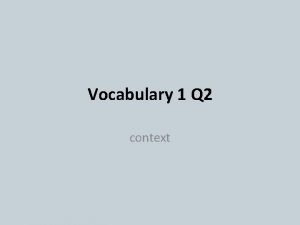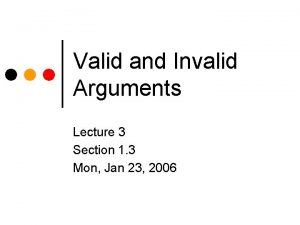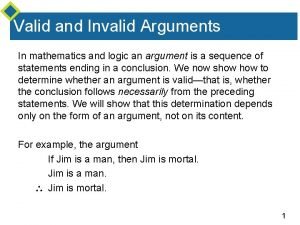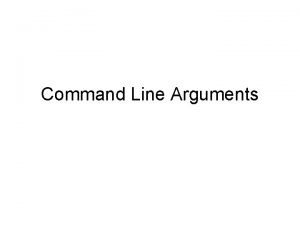ELACC 6 W 1 Write arguments to support







- Slides: 7

ELACC 6 W 1: Write arguments to support claims with clear reasons and relevant evidence. d. Establish and maintain a formal style. Tuesday, September 4 th, 2012 1) JOURNAL WRITE – 10 MINUTES 2) INFORMAL VS. FORMAL VOCABULARY MINI-LESSON 3) INFORMAL VS. FORMAL WRITING WORKSHOP

Journal Write ELACC 6 W 4: Produce clear and coherent writing in which the development, organization, and style are appropriate to task, purpose, and audience.

�Before we get to started, write down what you know about the differences between formal and informal styles of writing are. ELACC 6 W 1: Write arguments to support claims with clear reasons and relevant evidence. d. Establish and maintain a formal style.

Mini-Lesson: Formal and Informal Style � Example 1: This is to inform you that your book has been rejected by our publishing company as it was not up to the required standard. In case you would like us to reconsider it, we would suggest that you go over it and make some necessary changes. Example 2: You know that book I wrote? Well, the publishing company rejected it. They thought it was awful. But hey, I did the best I could, and I think it was great. I’m not gonna redo it the way they said I should. � These two examples are written to different audiences, but they demonstrate FORMAL and INFORMAL style. You decide: Which is formal? Which is informal? ELACC 6 W 1: Write arguments to support claims with clear reasons and relevant evidence. d. Establish and maintain a formal style.

Mini-Lesson: Formal and Informal Style � Example 1: This is to inform you that your book has been rejected by our publishing company as it was not up to the required standard. In case you would like us to reconsider it, we would suggest that you go over it and make some necessary changes. FORMAL Example 2: You know that book I wrote? Well, the publishing company rejected it. They thought it was awful. But hey, I did the best I could, and I think it was great. I’m not gonna redo it the way they said I should. � These two examples are written to different audiences, but they demonstrate FORMAL and INFORMAL style. You decide: Which is formal? Which is informal? ELACC 6 W 1: Write arguments to support claims with clear reasons and relevant evidence. d. Establish and maintain a formal style.

A few guidelines formal vs. informal writing: � Informal: May use colloquial words/expressions (kids, guy, awesome, a lot, etc. ). Formal: Avoid using colloquial words/expressions (substitute with children, man/boy, wonderful, many, etc. ) Informal: May use contractions (can’t, won’t, shouldn’t, etc. ). Formal: Avoid contractions (write out full words – cannot, will not, should not, etc. ). Informal: May use first, second, or third person. Formal: Write in third person (except in business letters where first person may be used).

Writers’ Workshop: Formal vs. informal writing �Look at your journal write from the beginning of class. Choose ONE “type” of person to write a short letter to in an informal style. �Next, choose another “type” of person to write a short letter to in a formal style. �Suggestions for fabulous teachers Modeling = a good idea here. Perhaps regarding “informal” style, text/Internet language could be discussed to bring relevancy to the topic. ELACC 6 W 1: Write arguments to support claims with clear reasons and relevant evidence. d. Establish and maintain a formal style.













